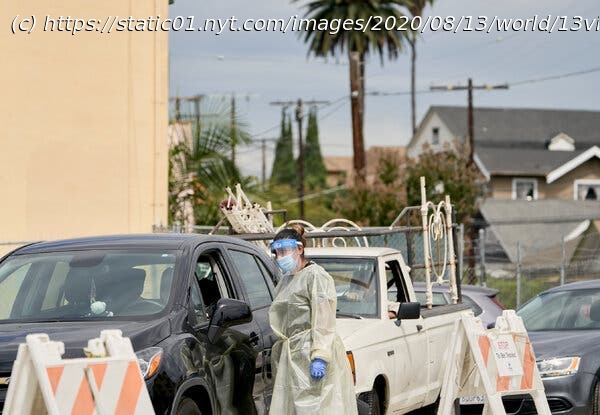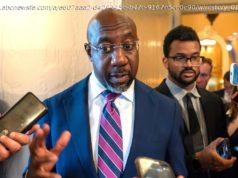North Korea lifted a lockdown as New Zealand extended one. Britain will require some travelers to self-isolate. France declared Paris a high-risk region for the virus.
This briefing has ended. Read live coronavirus updates here. California on Thursday became the first state to surpass 600,000 reported coronavirus cases since the virus arrived at the beginning of the year, a New York Times database shows. With more than 10,800 fatalities, the state now ranks third in the country for the worst death toll, behind New York and New Jersey, which were overwhelmed with cases in the spring but have since managed to contain the virus’s spread. Along with the Sun Belt states, California has been among the hardest hit in the summer resurgence of the virus, but the picture in California appears to have begun improving lately. Citing a 19 percent decline in the number of people hospitalized over the past two weeks, Gov. Gavin Newsom said on Wednesday that the state was “turning the corner on this pandemic.” By far the most populous state in the country, California has not been among the most severely affected states by the virus on a per-capita basis: It ranks 20th in cases and 28th in deaths when gauged that way, according to the Times database. After California’s disease reporting system broke down on July 25, the omission of around 300,000 files from the state’s main database muddied the picture of the virus’s progression in the state. But that problem has now been rectified, state officials say, and the higher numbers of cases reported this week are a result of entering the backlog of cases into the system. California has seesawed through the pandemic. It was the first state to issue a stay-at-home order, back in mid-March when it was reporting about 116 new cases a day, and it came to be seen as a national role model for how to confront the pandemic. But when the state started to reopen two months later, it was logging an average of 1,833 new cases a day — and over the past week, the daily figure has averaged around 8,000, including the backlogged cases. Public health officials have said the state reopened too soon. In an effort to contain the spread, Governor Newsom issued a statewide mask order on June 18, followed two weeks later by an order to close bars and indoor dining down again. Those settings have proved to be super-spreader sites in several other states. As the new school year has started across the state, most districts have stuck to online instruction. The border, the border, the border: That’s been the mantra for Australia and New Zealand since the coronavirus emerged. But both countries are now learning that their definition of the border, and border security, needs to expand to control the pandemic. In New Zealand, where a cluster that emerged on Tuesday had grown to 30 cases by Friday, officials struggled to explain a lack of regular testing for border officials and workers who manage hotel quarantine for the roughly 400 residents returning every day from overseas. One respected epidemiologist, Sir David Skegg, a professor at Otago University, called the lack of testing an “extraordinary” breach of known best practices. Investigators still haven’t determined how the virus re-entered the isolated Pacific country after 102 days without a case of community transmission.Prime Minister Jacinda Ardern, who on Friday extended a lockdown in Auckland for another 12 days, told reporters that officials had not yet linked the first identified case to either the border or quarantine facilities. But New Zealand’s process for handling returning citizens and residents has become a focal point, in part because new details have emerged about what caused the outbreak that is still raging in Australia. Leaked emails from government officials, published Friday by The Age, a newspaper in Melbourne, Australia, identified a hotel night manager as patient zero. He tested positive for the virus on May 26, and worked at one of the largest quarantine hotels in the city. Five security guards at the hotel later tested positive, after spreading the virus to relatives and their communities. A public inquiry into how passengers infected with the coronavirus were allowed to disembark a cruise ship in Sydney, Australia, in March, setting off a major outbreak, also handed down its findings on Friday. The detailed report from a panel of experts found a litany of “serious mistakes” and failures (a word the authors used 34 times) that ultimately led to 20 deaths in Australia and eight more in the United States. Chief among the errors was a lack of testing and the assumption that the ship’s 2,700 passengers were low-risk because they had come from New Zealand even though it was known that many of the arriving tourists had flown to their departure point from the United States and other high-risk locations. The border at the cruise ship terminal in central Sydney was porous, investigators found, and the virus broke through. “The events surrounding the ship’s voyage and disembarkation on 19 March 2020 will sadly have a lasting effect for many passengers and their families,” the report concluded. “It can only be hoped that this episode serves as a precautionary tale should public health authorities ever again encounter similarly challenging circumstances.” The communities with the highest rates of new cases relative to their populations all lie along the border with Mexico or on the Gulf Coast: Brownsville-Harlingen, Eagle Pass, Rio Grande City, Corpus Christi and Laredo, according to data compiled by The New York Times. Four of the five metro areas with the worst death rates in the country over the last two weeks were also in the South Texas border region. The numbers underscore the virulence of the virus in Texas, where officials have struggled to both keep the state open and curb infection. More than 300 deaths were announced in the state on Wednesday, and the state is approaching a total death toll of 10,000. Representative Filemon B. Vela Jr., a Democrat whose district includes Brownsville and Harlingen, said that in late June, he did not know anyone who had the virus. Now, he said, he knows hundreds. “In one day, I had four people who I knew die,” Mr. Vela said. In Laredo, hospitals have been at or near capacity every day. The state turned a local Red Roof Inn into a 106-bed temporary hospital for coronavirus patients with mild cases, but local leaders have been urging officials to allow patients with more serious cases in. “We see an unprecedented amount of death,” said Dr. Victor Treviño, the top health official in Laredo, adding, “When the state opened, that’s when we saw the infection rate increase dramatically.” Mr. Vela and other congressional Democrats in Texas have criticized Gov. Greg Abbott’s handling of the state’s reopening. When Mr. Abbott, a Republican, reopened the state in phases beginning May 1, he lifted the state’s stay-at-home order and prohibited local officials from adopting their own. After cases increased, Mr. Abbott paused the reopening, ordered bars to close and issued a mask mandate for most Texans. “Shutting down the bars isn’t enough,” said Mr. Vela, who called on the governor on Thursday to issue stay-at-home orders in hard-hit counties or allow local officials to put them in place. On Thursday, Mr. Abbott met with officials in the West Texas city of Lubbock and warned the public about what he called “Covid fatigue.” In remarks to reporters, he urged Texans to continue to wear masks, though he was without one as he spoke at an indoor news conference. “If people do not continue to, in a very disciplined way, maintain the highest level of standards, what you will see is an acceleration of the expansion of Covid-19,” the governor said. U. S. ROUNDUP The federal aid to unemployed workers that President Trump announced last weekend looks likely to be smaller than initially suggested — and it remains unclear when the money will start flowing, how long it will last or how many workers will benefit. The uncertainty comes at a delicate time for the economy. New applications for state unemployment benefits fell below one million last week for the first time since the pandemic took hold in March, the Labor Department said Thursday. But filings remain high by historical standards, and other measures show the economy losing momentum. A $600-a-week federal supplement to unemployment benefits, enacted to address the pandemic, stopped at the end of July. That has pulled away a key source of support, not just for the nearly 30 million Americans receiving benefits but also for the broader economy. “The status of the financial relief is a huge question mark hanging over the economy,” said Daniel Zhao, senior economist for the career site Glassdoor. Mr. Trump said Saturday that he was taking executive action to provide unemployed workers with $400 a week in extra payments, on top of their regular state jobless benefits. He did so after talks on a new round of pandemic relief stalled in Congress. Unlike the earlier supplement, which was fully funded by the federal government, the program called for states to chip in a quarter of the cost.






